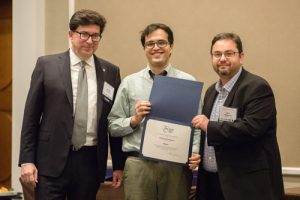Inspired by nature, Ph.D. candidate proposes computational framework to solve life problems
Real life problems are often complex and hard to resolve. So Mohammad Sarraf Joshaghani, a third year Ph.D. student at the Cullen College of Engineering, looks to nature, numerical techniques and computers to find possible solutions.
His research garnered Joshaghani first place in the Computational Mechanics Best Poster Competition at the 2018 Engineering Mechanics Institute (EMI) Conference. He was among 14 participants chosen from around the world to compete.
"Computational mechanics connects mathematics and mechanics and computer science, what could be better than that?" said Joshaghani, adding that his Ph.D work helped him see the connections. "We use all these tools to solve realistic problems."
The Research
“All the natural material around us, like rocks and soil or biological tissues and bones, are porous media, which means that they contain pores,” Joshaghani said. Fluids – such as water or blood –flow through complex and multi-layered pore networks carrying nutrients to cells and other destinations. Some networks consist of large pores and allow the fluid to flow easily, others have smaller pores and more restrictive flow – these co-exist and work together throughout nature.
Based on Joshaghani’s proposed formulation, he and his colleague Hanie Joodat created a mathematical framework for computers to model these complex network systems and numerically solve flow-transport issues. They later extended it to different flow-transport settings.
“This is the first time someone has done this type of formulation,” Joshaghani said. “The beauty of this field -- and of nature – is that you see the same patterns, the same governing equations again and again in different applications.”
Joshaghani’s framework can be used in several areas, including the medical field, oil and gas industry and in environmental research.
For example, it could be used to model patient-specific studies with information from the subject’s MRI scan to predict ruptures or brain aneurysms. Or doctors can use patient data and modeling to better administer treatment to individual heart patients.
Environmentally, the framework could be used with local data to model a hyporheic zone – a region under and alongside a stream bed where shallow groundwater and surface water mix.
“This mixing is critical because the ecosystem is very sensitive to contamination coming from runoff. Lots of hydrochemical processes take place at that specific region and it has been a concern of researchers for a long time,” Joshaghani said. “So it’s important for us to study and simulate this system and the framework will allow researchers to do that.”
The Next Step
The team is now working to make the modeling aspect more comprehensive, evolve interface problems and introduce other complex phenomena besides flow-transport to the framework to see how the formulation works in more areas.
Joshaghani (2014 MSCE) returned to the UH department of civil and environmental engineering (CEE) to pursue his Ph.D. in computational mechanics after working in the industry for a year. He now works at the UH Computational and Applied Mechanics Lab (CAML) under the guidance of Kalyana Babu Nakshatrala, associate professor of civil engineering.
“I’m really honored and grateful for this award,” Joshaghani said. “It wouldn’t be possible without teamwork so I would like to share this award with my colleague, Joodat, and thank all my professors, especially my research mentor Dr. Nakshratala.”

